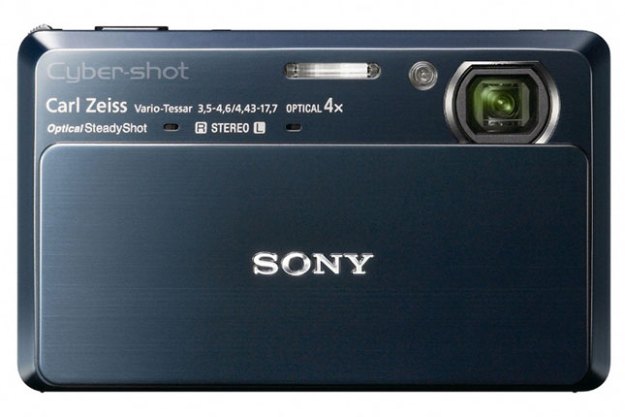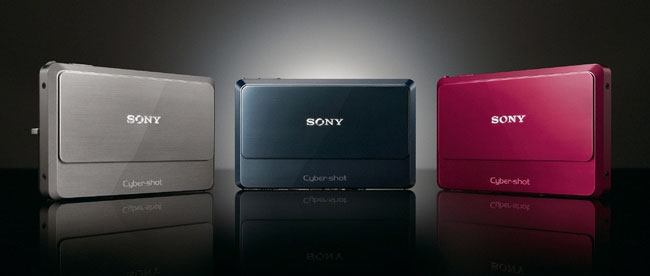
“Sony’s pocket-sized DSC-TX7 shoots high quality video comparable to many camcorders, along with stunning 10-megapixel stills.”
- Very high-quality 10MP stills
- Takes AVCHD video with stereo sound
- Nice wide-angle 4x zoom (25-100mm equivalent)
- Top notch 3.5-inch LCD screen
- Excellent touchscreen interface
- Expensive
- Controls could be too small for some; definitely do a hands-on test
- Nasty digital artifacts above ISO 800

Introduction
Let’s blow away the smoke—this is one of the best new digicams we’ve reviewed in a long time, well deserving its pick as an Editor’s Choice. It’s far from the perfect camera we’re always searching for but it does so many things well, it should go near the top of the list of anyone shopping for a new digicam. Why are we so juiced about the TX7? Read on and find out…
Features and Design
The Sony Cyber-shot DSC-TX7 features the classic sliding front panel of the company’s T series models we’ve reviewed over the years. We liked it when it originally arrived and it’s still cool in 2010. Just slide the panel down and the camera powers up. Since it uses a folding optics system, the 4x zoom lens does not extend from the body. The Carl Zeiss Vario-Tessar lens has a 35mm equivalent of 25-100mm, giving you a nice wide-angle for landscapes and portraits. Of course, we’d like more oomph on the telephoto side but no camera is perfect. You’ll have no problem popping this one in your pocket. Since it weighs 5.3 ounces with the battery, you can take it everywhere. Available in red, dark silver or blue finishes, the TX7 measures 3.9 x 2.4 x .7 (WHD, in inches). Our review unit was dark silver and it looked terrific.
When closed there are just a few embossed logos. When open you’ll see the lens, AF Assist lamp, flash and two small mics that record stereo sound, just one of the features that make this a standout.

The bottom has a compartment for the battery (rated an O.K. 230 images) and memory card. Sony’s 2010 models accept Memory Stick Pro Duo and SD/SDHC cards, a good consumer-friendly feature. Use high-speed, high-capacity media since you’ll definitely want to capture videos. Also on the bottom is a connector for the supplied Multi Output Stand (dock).
What’s In The Box
The TX7, battery/charger, A/V and USB cables, paint pen (stylus) and CD-ROM with Picture Motion Browser software and complete owner’s manual. You also get a Multi Output Stand, a fancy phrase for a dock with HDMI, A/V and USB outs as well as DC-in for an optional charger. Although no HDMI cable is supplied (no one gives you this), it’s a standard connection so no adaptors are required. We appreciate the small blessings especially since we recently used a Samsung DualView TL225 that requires a special adaptor to connect the HDMI cable – and were annoyed to no end.
With the Made In Japan camera charged and 2GB Memory Stick Pro Duo Mark 2 card loaded, we took tons of shots and videos on a trip to New Orleans, as picturesque a town as you can find.
 Performance and Use
Performance and Use
We spent days walking around the French Quarter and visiting other parts of town, day and night. The compact size of the TX7 made it effortless to have with us at all times, something you want from a camera.
The DSC-TX7 features Sony’s Exmor R CMOS chip. It’s “only” 10 megapixels but it’s capable of performing some incredible tricks when combined with the BIONZ processor used in the company’s alpha DSLRs. And by the way, 10MP is more than good enough for quality 8×10 prints, which this camera delivered in spades.
Perhaps the most outstanding feature of this camera is its ability to record 1920×1080 60I AVCHD video with stereo sound. While most digicams take HD video, it’s usually 720P at 30 fps. The TX7 does AVCHD at 17 Mbps, something only a $500 camcorder could do until this model (and the $349 Sony DSC-HX5V) arrived. We reviewed clips of a jazz band in Jackson Square on a 50-inch plasma that were excellent. The stereo sound added a nice depth to the brass players and crowd having a good time. The same held true for scenes of the Steamer Natchez blowing its whistle and leaving the dock, the red paddle wheel moving off to the distance. Colors were spot on with very little noise or “blocks.” Great stuff.
Another cool trick is 10—yes, 10—frames per second shooting. Most point-and-shoots take slightly more than 1 fps which is pretty useless for fast action. Firing 10 fps in burst mode grabs almost anything. There is a downside though. Unlike DSLRs that can crank off 3 or 4 fps for a 100 or more images, the TX7 stops after 10 to save the photos to the card. Still this is amazing for a compact camera.

Another cool option is Handheld Twilight. Also best with stationary objects, the camera grabs six frames in less than a second, combines them to create a shot taken in low light with low noise. We did this with the old-time Commander’s Palace sign and the results were outstanding (no jitter, hardly any digital artifacts). Dealing with difficult exposures is also a snap with Backlight Correction HDR. Here the camera takes two exposures, combines them for a more pleasing image overall.
And did we mention the camera takes excellent stills in the basic Intelligent Auto setting? Here the camera scientifically guesses the subject in front of it and adjusts accordingly. It did a fine job. We took many shots of the famous red and yellow street cars and the colors really popped and exposures overall were spot on. The same held true for many of the Quarter’s colorful old buildings.
Since the camera has a 9-point AF system, there was little grabbing and shot-to-shot time was fairly quick. The touchscreen system is very well designed and works with taps and swipes. Along with Canon’s new SD3500 IS, this interface is at the head of the class.
Not everything is wonderful with the TX7. Digital noise—the bête noir of all point-and-shoots—is an issue. Our test subject was fine up to ISO 400 and you could possibly get away with 800 for prints but 1600/3200 images were filled with artifacts. And Handheld Twilight has its noise issues as well.
Conclusion
We have no reservations whatsoever recommending the DSC-TX7. Is it a perfect camera? No such thing exists, but if you’re looking for a quality point-and-shoot capable of taking good stills and the best videos we’ve ever shot with a digicam, put this DigitalTrends’ Editor’s Choice at the top of your list.
Highs:
- Very high-quality 10MP stills
- Takes AVCHD video with stereo sound
- Nice wide-angle 4x zoom (25-100mm equivalent)
- Top notch 3.5-inch LCD screen
- Excellent touchscreen interface
Lows:
- Expensive
- Controls could be too small for some; definitely do a hands-on test
- Nasty digital artifacts above ISO 800
Editors' Recommendations
- The best point-and-shoot cameras
- Sony’s A7S III is the ultimate 4K video camera, five years in the making
- Sony RX100 VII vs. ZV-1: How does Sony’s vlog-focused compact stack up?
- Sony A7R IV vs. A7R III: An extra 20 megapixels isn’t the only difference
- 7 cameras that revolutionized photography and changed how we take pictures

 Performance and Use
Performance and Use

